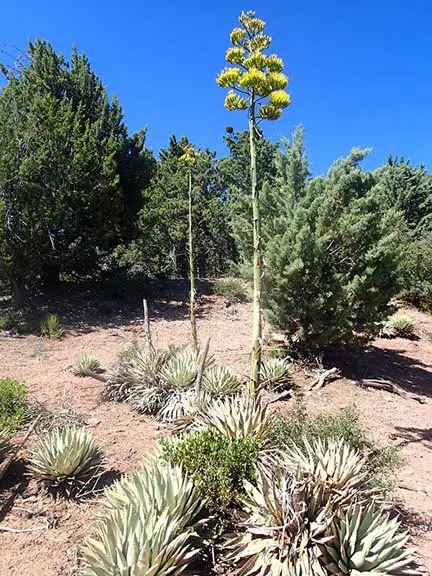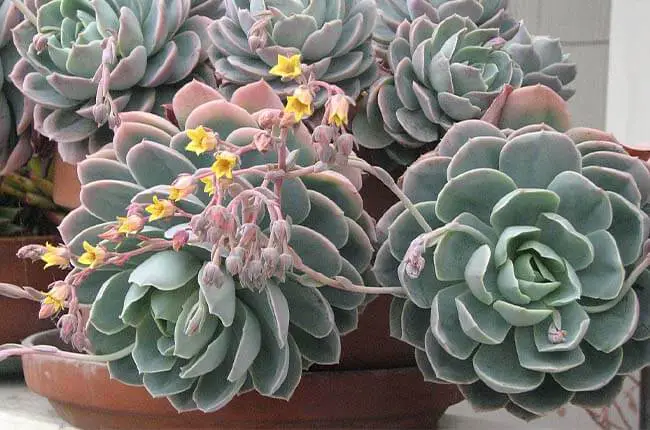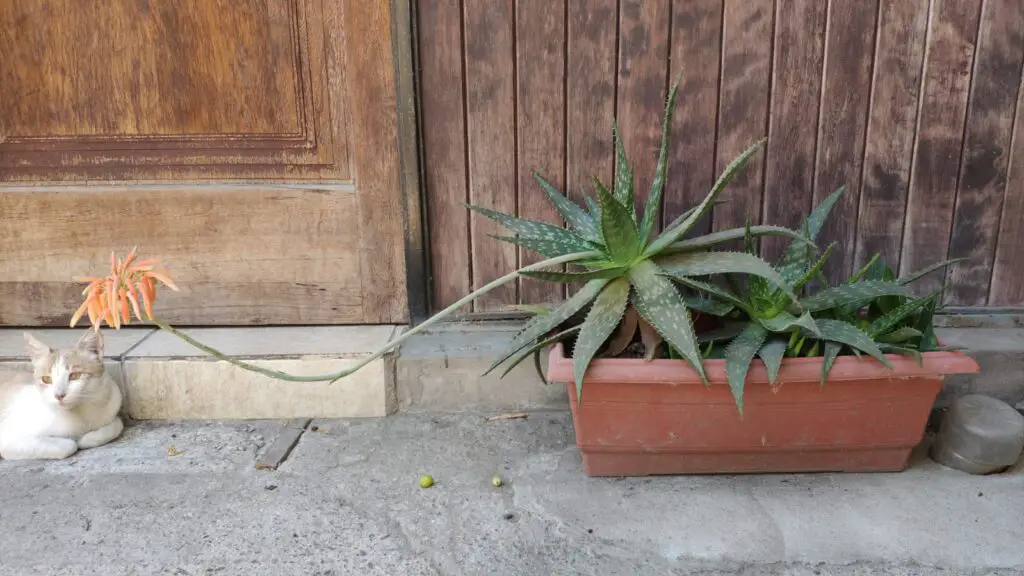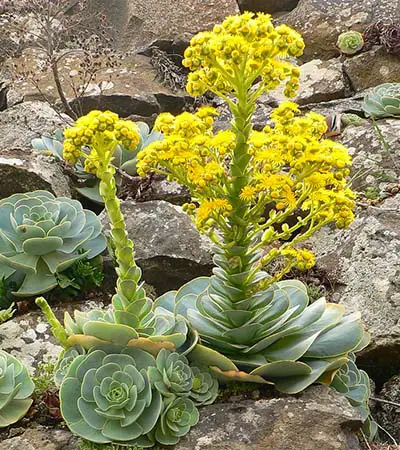Have you had succulents sending out a long flower stalk ready to bloom for the first time? Could this also be the last time? Could this possibly be a “death bloom”?
A death bloom is one single flower stalk that shoots up vertically from the apex of the plant only once in its lifetime. Succulents such as Sempervivums, Agave and some Aeoniums die after producing flowers and seeds, while others can do so many times in their lifetime and continue living.
Before you become too worried about whether your succulent will die after blooming, check out this article to help you identify what a death bloom really is, help you understand why it happens and what you should do about it.
1. What is a “death bloom”?
“Death bloom” refers to the event of a plant dying after it has finished blooming and produced seeds. The production of seeds causes hormonal changes inside the plant, redirecting resources and energy from the leaves and roots to the production of seeds and causing the plant to eventually wilt.
Death blooms only happen once in the lifetime of the plant when it is mature enough to reproduce. In the case of succulents, this would mean at least a few years, or even 80 years for some Agave species. If your succulent blooms multiple times, it does not produce a death bloom.
Death bloom is a natural part of the life cycle of annual plants, such as cabbage, tomato, peas, sunflower, which wilt and die after producing fruits and seeds.
2. What does a death bloom look like?
The characteristics of a succulent death bloom are that there is only one long single stalk shooting up vertically from the apex, or the very center of the plant.
At the early stage of a death bloom, the flower stalk will form buds, which will eventually bloom into tiny flowers. Once the flowers finish blooming, the succulent will wilt away in a few days or weeks.
Do not mistake the long stalk as a sign of insufficient light, resulting in leggy stems. In the case of a death bloom, only the flower stalk elongates.
For each species of succulents that undergoes a death bloom, their flowers will usually have a yellow or pink color similar to the flowers of the Agave genus. Sometimes, the flowers can also be orange or nearly white.

( Source: “La joubarbe des toits – Sempervivum tectorum” by museumdetoulouse is licensed under CC BY-SA 2.0,
“Common Houseleek – Sempervivum tectorum” by Björn S. is licensed under CC BY-SA 2.0 )
Depending on the species, the length of the flower stalks can vary between a few inches to 30 feet.
This table shows how long a death bloom in succulent can reach.
| Species | Length |
| Sempervivum tectorum | 8 to 12 inches |
| Kalanchoe luciae | 36 to 72 inches |
| Agave parviflora | 71 inches |
| Agave victoriae-reginae | 96 to 158 inches |
| Agave Americana | Up to 30 feet |

(Source: “Agave americana” by cogdogblog is licensed under CC BY 2.0)
Succulents also bloom at different times of the year. This table shows their different blooming seasons.
| Species | Blooming period |
| Agave parviflora | Summer |
| Agave victoriae-reginae | Mid-Summer |
| Kalanchoe luciae | Late winter to early spring |
| Sempervivum tectorum | Summer |
3. Why do succulents flower?
Like all plants in nature, succulents flower to reproduce, by attracting pollinators like bees to spread its seeds in different areas.
4. Do all succulents die after flowering?
Not all succulents will die after flowering. Those that do not die are called “polycarpic” and they can flower several times in their lifetime. Examples are Anacampseros, Aloe, and Mexican Grass (Dasylirion Longissimum).
5. Do Echeveria have death blooms?
Echeveria is a large genus of succulents in the Crassulaceae family. They are polycarpic, meaning they can flower and produce seeds many times over in their lifetime without experiencing death blooms.
One way to identify whether the plant is having a death bloom is to check its flower stalk. Succulents with flower stalks that grow from the apex, or the center, will die after blooming.
Succulents with flower stalks that come out horizontally from the sides between the leaves do not die after they finish blooming.
Even though Echeveria produces flowers, their flowers are not death blooms as they produce multiple flower stalks and their stalks emerge from the sides.

(Source: “Echeveria ‘Hummel #1′” by hortulus is licensed under CC BY 2.0)
6. Which succulents die after flowering?
Only “monocarpic” succulents develop a “death bloom”.
Monocarpic succulents are mostly Houseleeks (Sempervivium), those from the Agave genus, some Kalanchoe and some Aeoniums. Here are some examples of the common succulents which develop death bloom.
- Century Plant (Agave americana)
- Small Century Plant (Agave parviflora)
- Queen Victoria Agave (Agave victoriae-reginae)
- Blue Agave (Agave tequilana)
- Paddle Plant (Kalanchoe luciae)
- Hens and Chicks or Common Houseleek (Sempervivum tectorum)
- Bromeliad ‘Orange’ (Aechmea blanchetiana)
- Yucca Plant (Yucca queretaroensis)
- Tree Houseleek (Aeonium hybrids)
7. Why do some succulents die after flowering?
Scientists have yet agreed upon why some species die after producing flower and seeds while others continue living afterwards.
One explanation is that monocarpic succulents transfer the resources and energy from the roots and leaves to develop flowers and seeds for reproduction. Therefore, the plant does not have enough resources to sustain itself after blooming.
On the other hand, polycarpic plants can sustain themselves after flowering because they evenly distribute their cells to create more stems and leaves, which will provide them with more nutrients to survive after flowering
8. What to do when succulents flower?
For some monocarpic plants, they can be kept alive if the flowers are removed before seed formation begins, or even if the flower buds are removed before they begin blooming.
My suggestion is to cut a portion of the parent’s stem with the flower stalk (may be 2 inches below the rosette), best before it starts to flower. Put it in a vase with no soil and no water, let it bloom and produce seeds.
You will notice that the flowers detached from the mother plant will start to bloom in a month and produce seeds after another month. And with the parent, many succulent babies start to develop near the cutting of the stump.
This way you have a high chance of keeping the parent, as well as harvesting seeds for reproduction.
Take a look at this picture featuring our cat. Is this succulent having a death bloom? why or why not? tell us in our community.

Conclusion
A death bloom is the reproduction process of monocarpic succulents, which die after their flowers have bloomed. You can check if your succulent is monocarpic by checking if its flower stalk is shooting up vertically from the center or apex of the plant.
You can prolong its life by cutting its flower stalk before its buds come into bloom. This way, you can help your succulent save its energy and nutrients to sustain itself longer.
References
Amasino, R. (2009). Floral Induction and Monocarpic versus Polycarpic Life Histories. Genome Biology, 10(228).
Cabahug, R., Soh, S.Y. & Nam, S.Y. (2016). Growth of Crassulaceae Succulents as Influenced by Leaf Cutting Type and Planting Position. Flower Res. J., 24(4).
Cabahug, R., Nam, S.Y., Lim, K.B., Jeon, J.K. & Hwang, Y.J. (2018). Propagation Techniques for Ornamental Succulents. Flower Res. J. 26(3).
Chino Basin Water District. (2021). Queen Victoria Agave. InLand Valley Garden Planner.
Davis, P.J. & Gan, S. (2012). Towards an Integrated View of Monocarpic Plant Senescence. Russian Journal of Plant Physiology. 59(4), 467–478.
McGuire, G. (2019, May). Blooming & Dying: Agave within Tucson’s Built Environment. The University of Arizona.
Grant, B. (2021, March) Growing Monocarpic Succulents: What Succulents Are Monocarpic?
Iannotti, M. (2021, July). How to Grow Hens and Chicks (Sempervivum tectorum). The Spruce.
Rutherford, C., Groves, M., & Sajeva, M. (2018). Succulent Plants: A guide to CITES-listed species. Rutherford Groves Publishing.
Tanner, J. (2019). Mini-Show Succulent: Echeveria.
University of Arizona. (2012). Agave parviflora.
University of Wisconsin (2021). Flapjacks, Kalanchoe spp.
- Top 6 Drip Irrigation Systems for Raised Beds (2025) - January 31, 2025
- Top 10 Orchid Fertilizers: A Comprehensive Review (2025) - January 16, 2025
- Top 6 Slow-Release Fertilizers for Houseplants & Veggies (2025) - January 15, 2025

